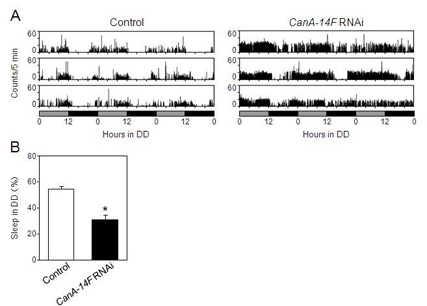
Jun Tomita, Madoka Mitsuyoshi, Taro Ueno, Yoshinori Aso, Hiromu Tanimoto, Yasuhiro Nakai, Toshiro Aigaki, Shoen Kume and Kazuhiko Kume. (2011) Pan-Neuronal Knockdown of Calcineurin Reduces Sleep in the Fruit Fly, Drosophila melanogaster . J. Neurosci. 31, 13137-13146.
Sleep is a unique physiological state, which is behaviorally defined, and is broadly conserved across species from mammals to invertebrates such as insects. Because of the experimental accessibility provided by various novel animal models including the fruit fly, Drosophila melanogaster , there have been significant advances in the understanding of sleep. Although the physiological functions of sleep have not been fully elucidated, accumulating evidence indicates that sleep is necessary to maintain the plasticity of neuronal circuits and, hence, is essential in learning and memory. Calcineurin (Cn) is a heterodimeric phosphatase composed of CnA and CnB subunits and known to function in memory consolidation in the mammalian brain, but its neurological functions in the fruit fly are largely unknown. Here, we show that Cn is an important regulator of sleep inDrosophila . A pan-neuronal RNA interference-mediated knockdown of Cnexpression resulted in sleep loss (Figure), whereas misexpression of the constitutively active form of a CnA protein led to increased sleep. Furthermore, CnA knockdown also impaired the retention of aversive olfactory memory. These results indicate a role for Cn and calcium-dependent signal transduction in sleep and memory regulation and may bring insight into the relationship between them.

Figure. Sleep loss due to CanA – 14F knockdown. (A) Locomotor activity profiles in 5 min intervals for three representative control (left panel) and pan-neuronal CanA – 14F knockdown flies (right panel) for 3 days in constant dark (DD) conditions. (B) Total sleep for control and CanA – 14F RNAi flies in DD conditions.